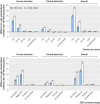Association between screening and the thyroid cancer "epidemic" in South Korea: evidence from a nationwide study
- PMID: 27903497
- PMCID: PMC5130923
- DOI: 10.1136/bmj.i5745
Association between screening and the thyroid cancer "epidemic" in South Korea: evidence from a nationwide study
Abstract
Objective: To investigate whether screening for thyroid cancer led to the current "epidemic" in South Korea.
Design: Review of the medical records of nationally representative samples of patients with a diagnosis of thyroid cancer in 1999, 2005, and 2008.
Setting: Sample cases were randomly selected from South Korea's nationwide cancer registry, using a systematic sampling method after stratification by region.
Participants: 5796 patients with thyroid cancer were included (891 in 1999, 2355 in 2005, and 2550 in 2008).
Main outcome measures: The primary outcome was age standardised incidence of thyroid cancer and the changes in incidence between 1999 and 2008 according to the methods used to detect tumours (screen detection versus clinical detection versus unspecified).
Results: Between 1999 and 2008, the incidence of thyroid cancer increased 6.4-fold (95% confidence interval 4.9-fold to 8.4-fold), from 6.4 (95% confidence interval 6.2 to 6.6) per 100 000 population to 40.7 (40.2 to 41.2) per 100 000 population. Of the increase, 94.4% (34.4 per 100 000 population) were for tumours less than 20 mm, which were detected mainly by screening. 97.1% of the total increase was localised and regional tumours according to the Surveillance, Epidemiology, and End Results (SEER) summary stage. Where cases were clinically detected, 99.9% of the increased incidences (6.4 per 100 000 population) over the same period were tumours less than 20 mm.
Conclusion: The current "epidemic" of thyroid cancer in South Korea is due to an increase in the detection of small tumours, most likely as a result of overdetection. Concerted efforts are needed at a national level to reduce unnecessary thyroid ultrasound examinations in the asymptomatic general population.
Published by the BMJ Publishing Group Limited. For permission to use (where not already granted under a licence) please go to http://group.bmj.com/group/rights-licensing/permissions.
Conflict of interest statement
All authors have completed the ICMJE uniform disclosure form at www.icmje.org/coi_disclosure.pdf and declare: no support from any organisation for the submitted work; no financial relationships with any organisations that might have an interest in the submitted work in the previous three years; and no other relationships or activities that could appear to have influenced the submitted work.
Figures



Comment in
-
Thyroid cancer: Overdiagnosis of papillary carcinoma - who benefits?Nat Rev Endocrinol. 2017 Mar;13(3):131-132. doi: 10.1038/nrendo.2016.224. Epub 2017 Jan 6. Nat Rev Endocrinol. 2017. PMID: 28059158 No abstract available.
References
-
- La Vecchia C, Malvezzi M, Bosetti C, et al. Thyroid cancer mortality and incidence: a global overview. Int J Cancer 2015;136:2187-95. 10.1002/ijc.29251 pmid:25284703. - DOI - PubMed
-
- Jung KW, Park S, Kong HJ, et al. Cancer statistics in Korea: incidence, mortality, survival, and prevalence in 2009. Cancer Res Treat 2012;44:11-24. 10.4143/crt.2012.44.1.11 pmid:22500156. - DOI - PMC - PubMed
-
- Won YJ, Sung J, Jung KW, et al. Nationwide cancer incidence in Korea, 2003-2005. Cancer Res Treat 2009;41:122-31. 10.4143/crt.2009.41.3.122 pmid:19809561. - DOI - PMC - PubMed
-
- Ferlay J, Soerjomataram I, Ervik M, et al. GLOBOCAN 2012 v1.0, cancer incidence and mortality worldwide: IARC CancerBase No. 11.International Agency for Research on Cancer, 2013, http://globocan.iarc.fr.
-
- Lee KS, Chang HS, Lee SM, Park EC. Economic burden of cancer in Korea during 2000-2010. Cancer Res Treat 2015;47:387-98. 10.4143/crt.2014.001 pmid:25672582. - DOI - PMC - PubMed
MeSH terms
LinkOut - more resources
Full Text Sources
Other Literature Sources
Medical
